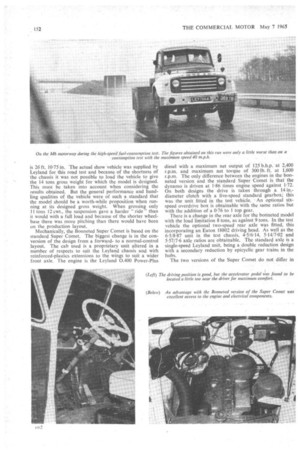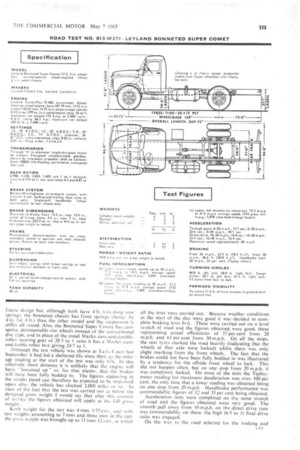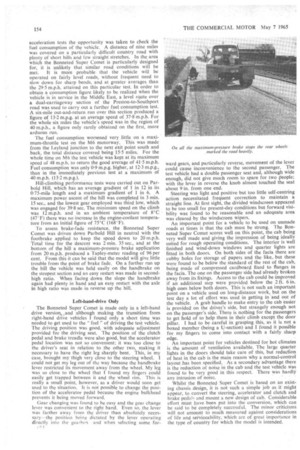Tailored
Page 153

Page 154

Page 155

Page 156

If you've noticed an error in this article please click here to report it so we can fix it.
By A. J. P. Wilding
A NII Pei ech E, MIRTE
ROAD TEST: Leyland Bonneted Super Comet
BR ITISH vehicle makers in general have always shown a willingness to design vehicles to suit particular markets. More often than not this is done by fairly simple and straightforward modifications to existing designs. such as the fitting of extra-capacity engine-cooling sNsterns for hot countries, special air-filtration systems for dusty areas. and so on. But occasionally it is necessary to make extensive modifications to a design to meet particular operating requirements. An excellent example of this is the Leyland Bonneted Super Comet which was featured at last year's Commercial Motor Show in London and which was designed specifically for marketing in 'Iran.
The background to this Model is interesting. Leyland was selling a lot of engines and gearboxes to its agent in Iran. Sherkat Haml va NaghIe of Teheran and discovered that these were being used to convert pewit 'imported American petrol-engined chassis. Realizing that there was good business if a design could be produced comparable with the American. vehicles involved, Leyland developed the bonneted version of the Super Cornet. Now. a total of 2.000 Bonneted Super Comets has been ordered by Leyland's agents in Iran and the model has been added to the Leyland range. A -number of order; have been received from other countries, too.
The model shown at Earls Court and those now being supplied to Iran differ in respect of wheelbases and overall length -because of the limited space that was available on the Leyland stand the show chassis had to be fairly short. The production model has a wheelbase of 17 ft. 8 in. compared with 13 ft. 3 in. on the show model and overall length
is 26 ft. 10-75 in. The actual show vehicle was supplied by Leyland for this road test and because of the shortness of the chassis it was not possible to load the vehicle to give the 14 tons gross weight for which the model is designed. This must be taken into account when considering the results obtained. But the general performance and handling qualities of the vehicle were of such a standard that the model should be a worth-while proposition when running at its designed gross weight. When grossing only II tons 12 cwt., the suspension gave a harder ride" than it would with a full load and because of the shorter wheelbase there was more pitching than there would have been on the production layout.
Mechanically, the Bonneted Super Comet is based on the standard Super Comet. The biggest change is in the conversion of the design from a forwardto a normal-control layout. The cab used is a proprietary unit altered in a number of respects to suit the Leyland chassis and with reinforced-plastics extensions to the wings to suit a wider front axle. The engine is the Leyland 0.400 Power-Plus diesel with a maximum net output of 125 b.h.p. at 2,400 r.p.m. and maximum net torque of 300 lb. ft. at 1,600 r.p.m. The only difference between the engines in the bonneted version and the standard Super Comet is that the dynamo is driven at 1-86 times engine speed against 1.72. On both designs the drive is taken through a 14 in.diameter clutch with a five-speed standard gearbox; this was the unit fitted in the test vehicle. An optional sixspeed overdrive box is obtainable with the same ratios but with the addition of a 0-76 to 1 top gear. There is a change in the rear axle for the bonneted model with the load limitation 8 tons, as against 9 tons. In the test vehicle the optional two-speed rear axle was fitted, this incorporating an Eaton 18802 driving head. As well as the 6-5/8.87 unit iii the test chassis, 4-5/614, 5-14/7-02 and 5-57/7.6 axle ratios are obtainable. The standard axle is a single-speed Leyland unit, being a double reduction design with a secondary reduction by epicyclic gear trains in the hubs.
The two versions of the Super Comet do not differ in
frame design but, although both have 4 ft. 6 in.-long rear 'springs, the bonneted chassis -has front springs shorter by 4 in. (at 4 ft.) than the other model and the suspension is stiller all round. Also, the Bonneted Super Cornet has castspoke, demountable-rim wheels instead of the conventional disc type, and in place of the usual Manes cani-and-doubleroller steering gear of 285 to I ratio it has a Manes camand-treble-roller box giving 247 to I.
Although the test vehicle was shown at Earls Court last September it had led a sheltered life since then, as the mile-' age reading at the start of the test was only 676. In this relatively short distance it is unlikely that the engine will have loosened up " or, for that matter, that the brakes will have been fully bedded in. The figures appearing in the results panel can. therefore be expected to be improved uPon after the vehicle has clocked 2,000 miles or so. In view of the fact that the test was carriedout at below the .designed gross weight 1 would say that after this ;Amount of service the figures obtained will apply at the full gross weight.
Kerb weight for the test was 4 tons F75 cwt., and with test weights amounting to 7 tons and three 'men in the cab, the gloss weight was brought up to II tons 12 cwt., al which all the tests were carried out. Because weather conditions at the start of the day were good it was decided to complete braking tests first. These were carried out on a level stretch of road and the figures obtained, were good, these representing actual efficiencies of 57 per cent from 20 m.p.ht. and 65 per cent from 30 m.p.h. On all the stops, the rear tyres marked the road heavily (indicating that the wheels at that axle were locked) whilst there was only slight marking from the front wheels. The fact that the brakes could not have been fully bedded in was illustrated by a tendency for the offside front wheel to lock. This did not happen often, but on one stop from 20 m.p.h. it was completely locked. On most of the tests the Tapleymeter reading for maximum deceleration was over 100 per cent, the only time that a lower reading was obtained being on one stop from 20 m.p.h. Handbrake performance was commendable, figures of 32 and 33 per cent, being obtained.
Acceleration tests were completed on the same stretch of road and the figures obtained were very good. The smooth pull away from 10 m.p.h. on the direct drive runs was commendable: on these, the high (6-5 to 1) final drive ratio was engaged.
On the way to the road selected for the braking and
acceleration tests the opportunity was taken to check the fuel consumption of the vehicle. A distance of nine miles was covered on a particularly difficult country road with plenty of short hills and few straight stretches. In the area which the Bonneted Super Comet is particularly designed for, it is unlikely that similar road conditions will be
met. It is more probable • that the vehicle will be operated on fairly level roads, without frequent need to slow down for sharp bends, and at greater averages than the 29.5 m.p.h. attained on this particular test. In order to obtain a consumption figure likely to be realized when the vehicle is in service in the Middle East, a level route over a dual-carriageway section of the Preston-to-Southport road was used to carry out a further fuel consumption test. A six-mile out-and-return run over this section produced a figure of 13-2 m.p.g. at an average speed of 37.8 m.p.h. For the whole six miles the vehicle's speed was in the region of 40 m.p.h., a figure only rarely obtained on the first, more arduous run.
The fuel consumption worsened very little on a maximum-throttle test on the M6 motorway. This was made from the Leyland junction to the next exit point south and back, the total distance covered being 15-5 miles. For the whole time on M6 the test vehicle was kept at its maximum speed of 48 m.p.h. to return the good average of 41-5 m.p.h. Fuel consumption was only 0-9 m.p.g. higher, at 12-3 m.p.g., than in the immediately previous test at a maximum of 40 m.p.h. (13-2 m.p.g.).
Hill-climbing performance tests were carried out on Parbold Hill, which has an average gradient of 1 in 12 in its 0.75-mile length and a maximum gradient of I in 6. A maximum power ascent of the hill was completed in 3 min. 15 sec., and the lowest gear employed was third low, which was engaged for 39-8.sec. The minimum speed on the climb was 12 m.p.h. and in an ambient temperature of 8°C (47°F) there was no increase in the engine-coolant temperature from an initial figure of 75°C (168°F).
To assess brake-fade resistance, the Bonneted Super Comet was driven down Parbold Hill in neutral with the footbrake applied to keep the speed down to 20 m.p.h. Total time for the descent was 2 mm. 35 sec., and at the bottom of the hill a maximum-pressure brake application from 20 m.p.h. produced a Tapley-meter reading of 96 per cent. From this it can be said that the model will give,little trouble from the point of brake fade. On a further run up the hill the vehicle was held easily on the handbrake on the steepest section and an easy restart was made in secondhigh ratio. When facing down the slope the handbrake again had plenty in hand and an easy restart with the axle in high ratio was made in reverse up the hill.
Left-hand-drive Only
The Bonneted Super Comet is made only in a left-hand drive versiont And although making the transition from right-hand drive vehicles I found only a short time was needed to get used to the "feel " of driving the test vehicle. The driving position was good, with adequate adjustment provided for the driving seat. The position of the clutch pedal and brake treadle were also good, but the accelerator pedal location was not so convenient; it was .too close to the driver's seat in relation to the other two, making it necessary to have the right leg sharply bent. This, in my Case, brought my thigh very close to the steering wheel. I could not get my leg out of the way because the handbrake lever restricted its movement away from the wheel. My leg was so close to the wheel that I found my fingers could easily get trapped between it and the wheel rim. This is really a small point, however, as a driver would soon get used to the situation. It is not possible to change the position of the accelerator pedal because the engine bulkhead prevents it being moved forward.
Gear changing was found to be easy and the gear change lever was convenient to the right hand. Even so, the lever was farther away from the driver than absolutely necessary—the position being dictated by the lever operating directly into the gearbox and when selecting some for 1.A 1
ward gears, and particularly reverse, movement of the lever could cause inconvenience to the second passenger. The test vehicle had a double passenger seat and, although wide enough, did not give much room to spare for two People; with the lever in reverse the knob almost touched the seat about 9 in. from one end.
Steering was light and positive but too little self-centring action necessitated frequent correction to maintain a straight line. At first sight, the divided windscreen appeared to be too small for present-day conditions but forward visibility was found to be reasonable and an adequate area was cleared by the windscreen wipers. An important point for a vehicle to be used on unmade roads at times is that the cab must be strong. The Bonneted Super Comet scores well on this point, the cab being very well made and giving the impression of being ideally suited for rough operating conditions. The interior is well finished and wind-down windows and quarter lights are fitted in both doors. On both sides of the facia there are cubby holes for storage of papers and the like,, but these were found to be below the standard of the rest of the cab, being made of compressed cardboard fixed to flanges in the facia. The one on the passenger side had already broken away from its fixings. Access to the cab could be improved if an additional step were provided below the 2 ft. 6 in. high ones below both doors. This is not such an important point on a vehicle used on long-distance work, but on the test day a lot of effort was used in getting in and out of the vehicle. A grab handle to make entry to the cab easier is provided on the driver's side, but strangely enough not on the passenger's side. There is nothing for the passengers to get hold of to help them in their climb except the door pillar. I had to be careful in grasping this, as it is not a boxed member (being a U-section) and I found it possible for my fingers to come into contact with a fairly sharp edge.
An important point for vehicles destined for hot climates is the amount of ventilation available. The large quarter lights in the doors should take care of this, but reduction of heat in the cab is the main reason why a normal-control layout has been specified. As a secondary advantage there is the reduction of noise in the cab and the test vehicle was found to be very good in this respect. There was• hardly' any intrusion of noise.
Whilst the Bonneted Super Comet is based on an existing chassis design, it is not such a simple job as it might appear, to convert the steering, accelerator and clutch and brake pedal,: and mount a new design of cab. Considerable effort must have been put into the conversion, which can be said to be completely successful. The minor criticisms will not amount to much measured against considerations of life and serviceability, which are of great importance in the type of country for which the model is intended.
























































































































































































































































